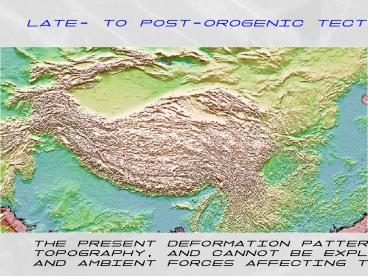LATE TO POSTOROGENIC TECTONIC PROCESSES - PowerPoint PPT Presentation
1 / 22
Title:
LATE TO POSTOROGENIC TECTONIC PROCESSES
Description:
LATE- TO POST-OROGENIC TECTONIC PROCESSES ... Late - to post-orogenic tectonic processes and ... not mark the end of the tectonic. activity in a mountainbelt. ... – PowerPoint PPT presentation
Number of Views:282
Avg rating:3.0/5.0
Title: LATE TO POSTOROGENIC TECTONIC PROCESSES
1
LATE- TO POST-OROGENIC TECTONIC PROCESSES
THE PRESENT DEFORMATION PATTERN HAS A STRONG
CORRELATION WITH TOPOGRAPHY, AND CANNOT BE
EXPLAINED ONLY FROM THE PLATE-MOTIONS AND
AMBIENT FORCES AFFECTING THE REGION
2
collision
subduction
3
(No Transcript)
4
Syn- to post-orogenic extension
Regional extension
Jolivet et al, 1999
5
- Late - to post-orogenic tectonic processes and
- exhumation mechanisms (ROCKS APPROACHING THE
SURFACE) - EROSION (MINOR ON A REGIONAL SCALE)
- THRUST STACKING EXTENSION AND/OR EROSION
- (IMPORTANT FOR BRINGING HP AND UHP ROCKS NEXT TO
EACH OTHER? - 3) VERTICAL CO-AXIAL SHORTENING/HORISONTAL
- STRETCHING
- (IMPORTANT FOR MID AND LOWER CRUST AFTER
EXHUMATION TO AMPHIBOLITE FACIES) - HINTERLAND EXTENSION FORLAND SHORTENING
- (IMPORTANT AT AN EARLY STAGE OF COLLISION)
- WHOLE-SALE EXTENSION BY PLATE-DIVERGENCE
- and/or TRANS-TENSION (IMPORTANT)
6
Map showing major earthquake fault plane
solutions and the topography in the
Himalayan-Tibetan Region. Notice the strong
correlation betwen altitude and contractional
earthquakes. Notice also the Dominant NW-SE of
the principal tension axes as shown by the normal
fault.plane solutions.
Normal fault-plane solution
Reverse fault-plane solution
Strike-slip fault-plane solution
(from Molnar and Lyon-Caen)
7
Horizontal projections of principal stress axes
directions derived from fault-plane solutions
(pink-reverse, blue-normal, green-strike-slip) in
the previous figure.
(Molnar and Lyon-Caen)
8
BODY FORCE FROM TOPOGRAPHY ON THE SURFACE AND ON
LITHSPHERE
AMBIENT FORCE FROM PLATE MOTION
9
(No Transcript)
10
Crust
Conductive geotherm
Lithospheric mantle
Adiabatic geotherm
Vertical stretching/lithospheric thickening
THE THERMAL EFFECT OF REMOVAL OF THICK MANTLE
LITHOSPHERE
Convective removal of thermal boundary layer
re-equilibration and extension
Higher geotherm leads to partial melting in the
lithosphere
Horizontal stretching/lithospheric thinning
Partial melting in astenosphere during
decompression
Modified from England Platt, 1994
11
From late to post orogenic tectonics
in continental collision zones to rifts
The end of a Wilson cycle does not mark the end
of the tectonic activity in a mountainbelt. In
many orogenic belts high-grade rocks formed by
the crustal-thickening during collision
get quickly exhumed. In many instances the
exhumation processes are too fast to be
accounted for by erosion alone. We have to
resort to tectonic processes to explain the
exhumation. The geology and seismic ativity in
several modern orogenic belts have an intimate
relationship between shortening and extension.
12
- Some definitions
- Exhumation --gt rocks approaching the surface.
- Uplift --gt rise of the earths surface
with respect to - reference level
- Subsidence --gt lowering of the earths surface
with respect to - reference level
- Extension gives some easily recognizable
features - Thermal Narrowing of isotherms steep
geotherm - Structural Normal faults and detachments
- Metamorphic Metamorphic hiatus exision across
structural - features
- 4) Sedimentary Creation of accomodation space
for sediments
13
An orogenic crust will, however, not go on
thickening forever and the topographic elevation
will reach a threshold value that depends on the
rate of convergence, the strength and density
structure of the orogenic lithsophere.
Plateau height h 3.5 km for a convergence rate
of ca 5 cm/year
- If convergence continues at this rate the plateau
will rise to the threshold value, - and then grow in width (spread laterally as
indicated by pink boxes). - For the avereage height (h) to increase, we
either have to - increase the rate of convergence,
- increase the strength of the rocks
- introduce a vertical force lifting the rocks
higher, - by reducing their average density so that they
will float higher.
14
- Increased topography will enhance the rate of
- exhumation within the thickened crust by
- EROSIONAL PROCESSES
- Increased topography will increase the
precipitation, hence - increase the rate of erosion
- Increased topography will increase the slope
instability, hence - enhance landsliding and mass transport
- TECTONIC PROCESSES
- Extensonal and strike-slip faulting to transport
material away - from toptgraphically elevated areas
15
- Mechanism resulting in extensional exhumation
- Underplating and extension (critical taper)
- Slab-breakoff and orogenic collapse
- Diapiric rise along density contrasts
- Subduction roll-back
- Plate divergence (including transtension)
16
Some good actualistic examples Himalaya - Tibet
plateau Region Mediterranean Region --gtAgean
Sea --gtItaly - Corsica section --gtAlboran
Sea (Spain - Morocco)
17
EXTENSION AT THE SAME TIME AS CONVERGENCE, SUBD
UCTION ROLL-BACK EXTENSION CHASES
AFTER CONTRACTION EASTWARD MIGRATION OF THE
EXTENSION AND COMPRESSION SINCE THE EARLY
TERTIARY
From Jolivet et al. 2004
18
From Jolivet et al. 2004
19
Late-to post Orogenic collapse
20
(No Transcript)
21
(No Transcript)
22
(No Transcript)































